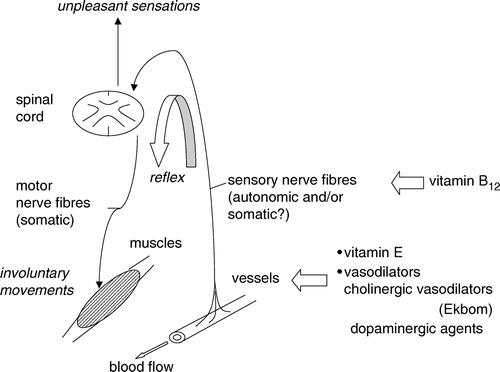Abstract
Restless legs syndrome (RLS) has been thought to be a basically neurological disorder, often observed among patients with sleep disturbance. Although the disease identity was proposed more than half a century ago, the pathogenesis of RLS has not been elucidated, and high prevalence of the disease has been demonstrated in many reports. I hypothesize that the crucial event for the occurrence of unpleasant sensations in the legs at night should be the change of blood flow dynamics. Acceleration of blood flow in the legs when lying down should stimulate nerve fibres which are closely located to the blood vessels. This hypothesis can explain many aspects of RLS, including symptoms as well as epidemiological findings. Treatment utilizing vitamin E might be extremely easy, safe, and inexpensive compared with the dopaminergic agents or opioids usually recommended for treatment.
Introduction
Restless legs syndrome (RLS), which was originally named by Ekbom in 1945, refers to unpleasant sensations in the legs, especially when lying down at night Citation[1], Citation[2]. The unpleasant sensations typically begin or worsen while patients are resting or lying down at night, and, as a rule, movement, walking, and stretching lead to dramatic relief of the sensations. Although the pathogenesis of RLS has not been elucidated, it has been thought to be a basically neurological disorder, and diagnostic criteria have been developed Citation[3].
Many reports have indicated that it occurs in 5–10% of the general population, and it has been described with a focus on the accompanying involuntary leg movements and sleep disturbance. Although the pathogenesis is still controversial, dopaminergic agents, benzodiazepines, opioids, and anticonvulsants are usually utilized for treatment Citation[4], Citation[5]. However, I often experience that patients feel an apparent improvement of the unpleasant sensations within only 7 days with a daily dose of 300 mg tocopherol acetate or tocopherol nicotinate (vitamin E), even without any topical ointment. Moreover, additional use of a daily 750-mg dose of mecobalamine (vitamin B12) might be effective for severe symptoms. I hypothesize that the unpleasant sensations of RLS are induced by stimulation of peripheral nerve fibres distributed along blood vessels, and that regulatory dysfunction of peripheral blood circulation might be the essential factor in patients’ legs. Lying down should affect the regulation of blood flow dynamics in the extremities, especially the lower legs. Acceleration of blood flow in vessels would increase the pressure of blood on the vessel walls, and subtle changes in vessel tension or shape might stimulate nerve fibres that are in anatomical proximity to the vessels. Vitamin E may stabilize peripheral blood circulation, suppressing abrupt deformation of vessels, whereas vitamin B12 may support the stability of nerve fibres, preventing excessive sensitivity.
This hypothesis explains several aspects of RLS. It is easy to explain why unpleasant sensations occur while lying down, and why relief is achieved by walking. Exacerbation during the later stages of pregnancy and disappearance of symptoms after delivery can also be explained by an alteration of blood flow dynamics. Dopaminergic agents would have a direct vasodilative effect. Iron deficiency, which has often been associated with RLS, may cause tachycardia, resulting in unstable regulation of peripheral blood circulation. The high incidence of RLS seems to be reasonable for a problem of peripheral blood circulation, showing a high familial incidence and a predilection for women and the elderly. An urge to move the leg might be a kind of withdrawal reflex caused by abnormal stimulation of the nerve fibres distributed to vessels or located in proximity to vessels. Somatic sensory nerve fibres interacting with or influenced by autonomic sensory nerve fibres might transfer the unpleasant sensations to the brain ().
Figure 1. Change of blood flow dynamics when lying down at night may stimulate sensory nerve fibres. A withdrawal reflex may cause involuntary movements in the legs. Relief of unpleasant sensations could be induced by stabilization of blood vessels and sensory nerve fibres.

I suppose that the disease identity of RLS has unexpectedly expanded beyond the original delineation described by Ekbom. I believe that alteration of blood flow dynamics is one of the events for triggering the unpleasant sensations in RLS, and Ekbom also originally described the effect of cholinergic vasodilators Citation[1], Citation[2]. However, the use of vasodilators has not been referred to in later reports, and even denied Citation[6]. It appears that no previous report has addressed the involvement of blood flow dynamics. I propose that vitamin E alone or in combination with vitamin B12 must first be attempted for treatment, rather than dopaminergic and other agents that are costly and may have the potential to cause adverse effects.
Acknowledgements
I thank Dr Eri Sugita and Dr Kazuo Nomura for valuable discussions.
References
- Ekbom KA. Restless legs: a clinical study. Acta Med Scand 1945; 158 Suppl: 1–123
- Ekbom KA. Restless legs syndrome. Neurol 1960; 10: 868–73
- Allen RP, Picchietti D, Hening WA, Trenkwalder C, Walters AS, Montplaisi J. Restless legs syndrome: diagnostic criteria, special considerations, and epidemiology: a report from the restless legs syndrome diagnosis and epidemiology workshop at the National Institutes of Health. Sleep Med 2003; 4: 101–19
- Thorpy MJ. New paradigms in the treatment of restless legs syndrome. Neurol 2005; 64(Suppl 3)S28–33
- Hening WA, Allen RP, Earley CJ, Picchietti DL, Silber MH. An update on the dopaminergic treatment of restless legs syndrome and periodic limb movement disorder. A review by the Restless Legs Syndrome Task Force of the Standards of Practice Committee of the American Academy of Sleep Medicine. Sleep 2004; 27: 560–83
- Hening W, Allen R, Earley C, Kushida C, Picchietti D, Silber M. The treatment of restless legs syndrome and periodic limb movement disorder. An American Academy of Sleep Medicine Review. Sleep 1999; 22: 970–99